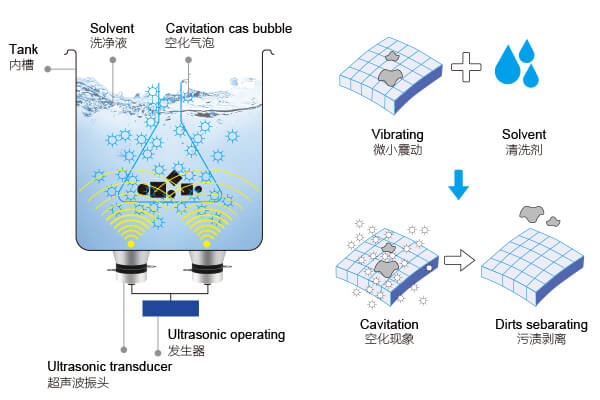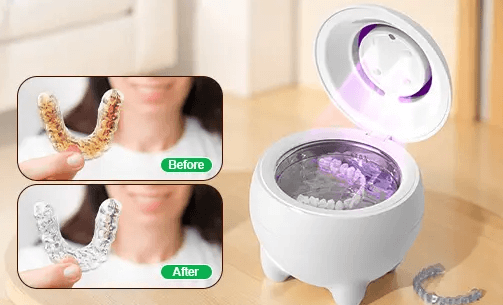It’s not uncommon to wonder whether your daily dental routine could be more efficient—or even a little gentler on your dentures. After all, if ultrasonic cleaners can restore jewelry and lab instruments to sparkling clarity, why not dentures too? But the question isn’t just about effectiveness. It’s about safety. Can these powerful cleaning machines harm the very materials that keep your smile intact?
Ultrasonic cleaners are loved for their precision, but they also come with misunderstood risks—especially when it comes to something as personal and delicate as dental prosthetics. As with any high-frequency technology, the line between helpful and harmful often depends on how the tool is used, not just whether it’s used at all.
To answer whether ultrasonic cleaning is safe for dentures, we have to first explore how ultrasonic cleaning works, what dentures are made of, and how these two systems interact. Only then can we decide if this method enhances hygiene—or risks undermining it.
What Makes Ultrasonic Cleaning So Effective?
Ultrasonic cleaning is a fascinating blend of physics and practical cleaning power. It doesn’t rely on scrubbing, abrasives, or high-pressure water jets. Instead, it harnesses sound—specifically high-frequency sound waves (typically 20 to 80 kilohertz)—to create microscopic cavitation bubbles in a liquid cleaning solution. When these bubbles collapse, they release tiny shockwaves that dislodge contaminants from surfaces, including places that brushes or floss could never reach.

The Principle Behind Ultrasonic Cleaning
What makes this especially useful for dental devices is that it cleans into crevices, porous surfaces, and tight angles. For dentures with intricate contours or retention clips, this ability can significantly improve hygiene outcomes by removing biofilm, plaque, or even stubborn tartar.
But here’s where the magic meets potential caution: the same energy that makes ultrasonic cleaning powerful can, under the wrong conditions, also stress or damage delicate materials—especially if they’re already worn or cracked.
What Are Dentures Made Of, and Why Does It Matter?
To understand how ultrasonic cleaning might affect dentures, you first need to look at what they’re made of. Most full or partial dentures consist of an acrylic resin base (often polymethyl methacrylate, or PMMA) and artificial teeth made of acrylic or sometimes porcelain. Partial dentures may also include metal frameworks, usually cobalt-chromium alloy or titanium.
These materials are engineered to be biocompatible and durable—but not necessarily invincible.
Acrylic, for example, is a slightly porous polymer. While it’s tough, it can develop microcracks over time, especially if exposed to sudden pressure shifts or prolonged vibration. And though metals used in partial dentures are corrosion-resistant, they’re not immune to oxidation or fatigue if exposed to high-energy cavitation without the right buffer.
So, when someone asks, “Can ultrasonic cleaning harm dentures?” the answer isn’t a clear yes or no. It’s more like: “It depends on the cleaner, the duration, the temperature, and what exactly the denture is made of.”
Let me know when you’re ready for the next section, where we’ll explore scientific findings and professional guidelines on ultrasonic denture cleaning.
What the Science and Dental Professionals Say
Dental researchers and prosthodontists have been studying ultrasonic cleaning of dentures for decades, and the general consensus is that—when done correctly—it’s not only safe, but highly effective.
For instance, a clinical review published in the Journal of Prosthetic Dentistry found that ultrasonic cleaners removed significantly more microbial biofilm and calculus than brushing alone, especially from hard-to-reach areas of dentures. Another study in the International Journal of Dental Hygiene concluded that daily ultrasonic cleaning improved denture hygiene and reduced halitosis-causing bacteria, especially in elderly or mobility-restricted individuals who struggle with manual cleaning.
However, these benefits come with qualifiers.
Many studies emphasize the importance of gentle settings—lower ultrasonic power levels, shorter durations, and cooler water temperatures (ideally below 45°C). Higher power settings, especially in older or lower-quality machines, can cause premature wear or introduce microfractures into already stressed acrylic surfaces. Similarly, if a denture has been relined or repaired with temporary materials, the vibrations can compromise bonding or dislodge fragile components.
That’s why most dental clinics use specialized ultrasonic units designed specifically for prosthodontic applications, often combined with pH-neutral enzymatic or antimicrobial cleaning solutions.
When Ultrasonic Cleaning Becomes Harmful
Despite its effectiveness, ultrasonic cleaning isn’t universally recommended for every denture or user. Let’s explore the risks and when caution is warranted:
- Cracked or old dentures: If your dentures already have visible cracks or have been in use for over 5 years without maintenance, ultrasonic vibrations might exacerbate these faults. Even microscopic fractures can widen under repeated exposure, leading to breakage.
- Soft liners or reline materials: Some dentures have soft liners made from silicone or plasticized acrylic, which are designed to cushion the fit against sensitive gums. These materials are more vulnerable to ultrasonic agitation, especially when paired with alkaline or enzymatic solutions that may degrade them.
- Metal components and clasps: While most cobalt-chromium frameworks hold up well in ultrasonic cleaning, cheaper metals or poor solder joints can corrode or loosen over time. This is especially true if you’re using water without anti-corrosive additives.
- Incorrect cleaning solutions: Harsh detergents or solutions with high alkalinity (above pH 10) can cloud acrylic, weaken bonding agents, or corrode metal over time. Distilled water with mild detergent or enzymatic tablets specifically formulated for dentures is always the safest route.
This is where reading your manufacturer’s cleaning guide—or better yet, consulting your dentist—can make a difference.
Best Practices for Using an Ultrasonic Cleaner on Dentures at Home
If you’ve decided to bring an ultrasonic cleaner into your daily denture care routine, congratulations—you’re embracing a professional-grade tool. But, like any tool, its effectiveness (and safety) depends entirely on how you use it.
Start with the Right Machine
Not all ultrasonic cleaners are created equal. For dentures, a compact cleaner with a tank capacity of around 600 ml to 1 liter is usually sufficient. Prioritize models with adjustable timer and temperature settings, and avoid ones with excessive power output designed for industrial applications—these can be overkill for delicate oral appliances. A unit with a frequency around 40 kHz is ideal, offering thorough cleaning while being gentle enough on denture materials.
Always Use a Cleaning Basket
Place your dentures in the provided mesh or plastic basket rather than directly at the bottom of the tank. This minimizes contact with the vibrating transducers and ensures even cavitation across all surfaces. Direct contact with the metal base can lead to pitting or acoustic shadows, reducing cleaning efficiency and damaging the appliance.
Select the Right Liquid
Use distilled or deionized water as the base to prevent mineral deposits. Add a small amount of an enzymatic denture cleaner or a mild pH-neutral detergent. Avoid bleach, alcohol-based solutions, or high-alkaline degreasers—all of which can degrade acrylic and metal over time.
Watch the Time and Temperature
Set the timer between 3 to 6 minutes for routine cleaning. Prolonged sessions may damage delicate materials. The water should be lukewarm—ideally around 35 to 40°C. Avoid using hot water, as excessive heat can warp the acrylic or loosen the bond in layered prosthetics.
Rinse and Dry Thoroughly
After each cleaning session, rinse the dentures under cool running water to remove any leftover detergent or dislodged debris. Pat them dry with a clean microfiber cloth. Never store dentures while damp inside the machine.
How Often Should You Use an Ultrasonic Cleaner for Dentures?
Ultrasonic cleaning is powerful, but it doesn’t necessarily need to be done daily. A good routine might look like this:
- Daily maintenance: Rinse and brush with a soft toothbrush or denture brush, preferably without abrasive toothpaste.
- 2 to 3 times per week: Use the ultrasonic cleaner for a deeper clean, especially if you notice plaque buildup or staining.
If your dentist recommends more frequent cleaning due to specific oral health needs—such as fungal infections or chronic halitosis—then the schedule can be adjusted accordingly.
Can Ultrasonic Cleaners Replace Manual Denture Cleaning Entirely?
It’s tempting to imagine a world where your denture care routine is as simple as pressing a button and walking away. And in some respects, ultrasonic cleaning brings us remarkably close to that. But does that mean you can ditch your denture brush and forget about manual care altogether?
Not quite.
Despite their effectiveness, ultrasonic cleaners are still best viewed as a complementary solution rather than a complete replacement for manual cleaning. Why? Because ultrasonic cavitation, while excellent at dislodging biofilm and debris from hard-to-reach areas, may not always remove stubborn surface stains or soft plaque as effectively as gentle brushing.
This is particularly important in areas where calculus or tartar is forming, or where staining from coffee, tea, or tobacco has begun to set in. Ultrasonic waves can’t “scrub” these spots in the traditional sense—they loosen and dislodge, but without a mechanical follow-up (like a soft brush), some residue can remain. It’s the same reason dentists still recommend brushing even after using a professional mouth rinse.
Moreover, brushing plays another important role: visual inspection. While cleaning your dentures manually, you’re more likely to spot early signs of wear, micro-cracks, loose clasps, or developing discoloration. Relying solely on a machine may remove this valuable feedback loop from your routine.
So what’s the ideal approach?
Think of your ultrasonic cleaner like a dishwasher: it handles the bulk of the work beautifully, but you still scrape off big particles before loading it, and occasionally scrub something by hand when needed. The synergy of both methods ensures the cleanest, safest results.
A Final Word on Comfort, Hygiene, and Longevity
Proper denture care isn’t just about cleanliness—it’s deeply tied to comfort, oral health, and the lifespan of your prosthetics. Poor hygiene can lead to infections like stomatitis or candidiasis, while aggressive or improper cleaning techniques can cause irreparable material damage or shorten the functional life of your dentures.
When used correctly, an ultrasonic cleaner is not only safe but highly beneficial for denture hygiene. It elevates your daily routine from “good enough” to “professional grade” with minimal effort and excellent results. But like any tool, its value comes from thoughtful, informed use—not shortcuts.
So, is it harmful to clean dentures with an ultrasonic cleaner? On the contrary—when paired with common sense and proper technique, it may be one of the best habits you can adopt for your oral appliance care.


